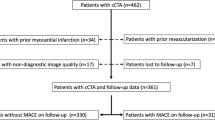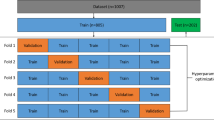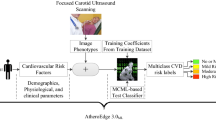Abstract
Objectives
Utilising readily available clinical variables, we aimed to develop and validate a novel machine learning (ML) model to predict severe coronary calcification, and further assessed its prognostic significance.
Methods
This retrospective study enrolled patients who underwent coronary CT angiography and subsequent invasive coronary angiography. Multiple ML algorithms were used to train the models for predicting severe coronary calcification (cardiac CT-measured coronary artery calcium [CT-CAC] score ≥ 400). The ML-based CAC (ML-CAC) score derived from the ML predictive probability was stratified into quartiles for prognostic analysis. The primary endpoint was a composite of all-cause death, nonfatal myocardial infarction, or nonfatal stroke.
Results
Overall, 5785 patients were divided into training (80%) and test sets (20%). For clinical practicability, we selected the nine-feature support vector machine model with good and satisfactory performance regarding both discrimination and calibration based on five repetitions of the 10-fold cross-validation in the training set (mean AUC = 0.715, Brier score = 0.202), and based on the test in the test set (AUC = 0.753, Brier score = 0.191). In the test set cohort (n = 1137), the primary endpoint was observed in 50 (4.4%) patients during a median 2.8 years’ follow-up. The ML-CAC system was significantly associated with an increased risk of the primary endpoint (adjusted hazard ratio for trend 2.26, 95% CI 1.35–3.79, p = 0.002). There was no significant difference in the prognostic value between the ML-CAC and CT-CAC systems (C-index, 0.67 vs. 0.69; p = 0.618).
Conclusion
ML-CAC score predicted from clinical variables can serve as a novel prognostic indicator in patients referred for invasive coronary angiography.
Clinical relevance statement
In patients referred for invasive coronary angiography who have not undergone preoperative CT-measured coronary artery calcium scoring, machine learning–based coronary artery calcium score assessment can serve as an alternative for predicting the prognosis.
Key Points
• The coronary artery calcium (CAC) score, a solid prognostic indicator, can be predicted using non-CT methods.
• We developed a machine learning (ML)-CAC model utilising nine clinical variables to predict severe coronary calcification.
• The ML-CAC system offers significant prognostic value in patients referred for invasive coronary angiography.





Similar content being viewed by others
Abbreviations
- AUC:
-
Area under the curve
- BNP:
-
B-type natriuretic peptide
- CAD:
-
Coronary artery disease
- CAC:
-
Coronary artery calcium
- CONFIRM:
-
Coronary CT Angiography Evaluation for Clinical Outcomes: An International Multicenter
- CI:
-
Confidence interval
- CTA:
-
Computed tomography angiography
- CT:
-
Computed tomography
- CVD:
-
Cerebral vascular disease
- eGFR:
-
Estimated glomerular filtration rate
- HR:
-
Hazard ratio
- ICA:
-
Invasive coronary angiography
- IDI:
-
Integrated discrimination improvement
- LASSO:
-
Least absolute shrinkage and selection operator
- LR:
-
Logistic regression
- LVESD:
-
Left ventricular end-systolic diameter
- ML:
-
Machine learning
- MLP:
-
Multilayer perceptron
- NRI:
-
Net reclassification improvement
- RCS:
-
Restricted cubic splines
- RBC:
-
Red blood cell
- RF:
-
Random forest
- ROC:
-
Receiver operating characteristic
- SHAP:
-
SHapley Additive exPlanations
- SVM:
-
Support vector machine
- XGB:
-
Extreme gradient boosting
References
Arnett DK, Blumenthal RS, Albert MA et al (2019) 2019 ACC/AHA Guideline on the Primary Prevention of Cardiovascular Disease: executive summary: a report of the American College of Cardiology/American Heart Association Task Force on Clinical Practice Guidelines. J Am Coll Cardiol 74:1376–1414
McClelland RL, Jorgensen NW, Budoff M et al (2015) 10-year coronary heart disease risk prediction using coronary artery calcium and traditional risk factors: derivation in the MESA (Multi-Ethnic Study of Atherosclerosis) with validation in the HNR (Heinz Nixdorf Recall) study and the DHS (Dallas Heart Study). J Am Coll Cardiol 66:1643–1653
Óh B, Gransar H, Callister T et al (2018) Development and validation of a simple-to-use nomogram for predicting 5-, 10-, and 15-year survival in asymptomatic adults undergoing coronary artery calcium scoring. JACC Cardiovasc Imaging 11:450–458
Lo-Kioeng-Shioe MS, Rijlaarsdam-Hermsen D, van Domburg RT et al (2020) Prognostic value of coronary artery calcium score in symptomatic individuals: a meta-analysis of 34,000 subjects. Int J Cardiol 299:56–62
Gulati M, Levy PD, Mukherjee D et al (2021) 2021 AHA/ACC/ASE/CHEST/SAEM/SCCT/SCMR Guideline for the Evaluation and Diagnosis of Chest Pain: a report of the American College of Cardiology/American Heart Association Joint Committee on Clinical Practice Guidelines. J Am Coll Cardiol 78:e187–e285
Quer G, Arnaout R, Henne M, Arnaout R (2021) Machine learning and the future of cardiovascular care: JACC state-of-the-art review. J Am Coll Cardiol 77:300–313
Rim TH, Lee CJ, Tham YC et al (2021) Deep-learning-based cardiovascular risk stratification using coronary artery calcium scores predicted from retinal photographs. Lancet Digit Health 3:e306–e316
Abbara S, Blanke P, Maroules CD et al (2016) SCCT guidelines for the performance and acquisition of coronary computed tomographic angiography: a report of the society of Cardiovascular Computed Tomography Guidelines Committee: Endorsed by the North American Society for Cardiovascular Imaging (NASCI). J Cardiovasc Comput Tomogr 10:435–449
Agatston AS, Janowitz WR, Hildner FJ, Zusmer NR, Viamonte M Jr, Detrano R (1990) Quantification of coronary artery calcium using ultrafast computed tomography. J Am Coll Cardiol 15:827–832
Lamelas P, Belardi J, Whitlock R, Stone GW (2019) Limitations of repeat revascularization as an outcome measure: JACC review topic of the week. J Am Coll Cardiol 74:3164–3173
Vickers AJ, Elkin EB (2006) Decision curve analysis: a novel method for evaluating prediction models. Med Decis Making 26:565–574
Lundberg SM, Lee SI (2017) A unified approach to interpreting model predictions. Curran Associates Inc 4768–4777
Yuan N, Kwan AC, Duffy G et al (2023) Prediction of coronary artery calcium using deep learning of echocardiograms. J Am Soc Echocardiogr 36(5):474–481
Lee J, Lim JS, Chu Y et al (2020) Prediction of coronary artery calcium score using machine learning in a healthy population. J Pers Med 10(3):96
Park S, Hong M, Lee H et al (2021) New model for predicting the presence of coronary artery calcification. J Clin Med 10(3):457
Zhu H, Yin C, Schoepf UJ et al (2022) Machine learning for the prevalence and severity of coronary artery calcification in nondialysis chronic kidney disease patients: a Chinese large cohort study. J Thorac Imaging 37:401–408
Han D, Klein E, Friedman J et al (2020) Prognostic significance of subtle coronary calcification in patients with zero coronary artery calcium score: from the CONFIRM registry. Atherosclerosis 309:33–38
Budoff MJ, Kinninger A, Gransar H et al (2023) When Does a calcium score equate to secondary prevention?: insights from the multinational CONFIRM Registry. JACC Cardiovasc Imaging 16:1181–1189
Jia S, Li J, Zhang C et al (2020) Long-term prognosis of moderate to severe coronary artery calcification in patients undergoing percutaneous coronary intervention. Circ J 85:50–58
Cho I, Chang HJ, Hartaigh BO et al (2015) Incremental prognostic utility of coronary CT angiography for asymptomatic patients based upon extent and severity of coronary artery calcium: results from the COronary CT Angiography EvaluatioN For Clinical Outcomes InteRnational Multicenter (CONFIRM) study. Eur Heart J 36:501–508
Gerke O, Lindholt JS, Abdo BH et al (2022) Prevalence and extent of coronary artery calcification in the middle-aged and elderly population. Eur J Prev Cardiol 28:2048–2055
Javaid A, Dardari ZA, Mitchell JD et al (2022) Distribution of coronary artery calcium by age, sex, and race among patients 30–45 years old. J Am Coll Cardiol 79:1873–1886
Mori H, Torii S, Kutyna M, Sakamoto A, Finn AV, Virmani R (2018) Coronary artery calcification and its progression: what does it really mean? JACC Cardiovasc Imaging 11:127–142
Gan T, Hu J, Liu W et al (2023) Causal association between anemia and cardiovascular disease: a 2-sample bidirectional Mendelian randomization study. J Am Heart Assoc 12(12):e029689
Savarese G, von Haehling S, Butler J, Cleland JGF, Ponikowski P, Anker SD (2023) Iron deficiency and cardiovascular disease. Eur Heart J 44:14–27
Liu J, Huang Z, Huang H et al (2022) Malnutrition in patients with coronary artery disease: prevalence and mortality in a 46,485 Chinese cohort study. Nutr Metab Cardiovasc Dis 32:1186–1194
Bos D, Ikram MA, Elias-Smale SE et al (2011) Calcification in major vessel beds relates to vascular brain disease. Arterioscler Thromb Vasc Biol 31:2331–2337
Kim BJ, Lee SH, Kim CK et al (2011) Advanced coronary artery calcification and cerebral small vessel diseases in the healthy elderly. Circ J 75:451–456
Funding
This study was funded by National Natural Science Foundation of China (No. 81970291 and No. 82170344).
Author information
Authors and Affiliations
Corresponding author
Ethics declarations
Guarantor
The scientific guarantor of this publication is **ghua Liu.
Conflict of interest
The authors of this manuscript declare no relationships with any companies, whose products or services may be related to the subject matter of the article.
Statistics and biometry
No complex statistical methods were necessary for this paper.
Informed consent
Written informed consent was waived by the Institutional Review Board.
Ethical approval
Institutional Review Board approval was obtained.
Study subjects or cohorts overlap
No study subject or cohort overlap reported.
Methodology
• Retrospective
• Observational
• Performed at one institution
Additional information
Publisher's Note
Springer Nature remains neutral with regard to jurisdictional claims in published maps and institutional affiliations.
Supplementary Information
Below is the link to the electronic supplementary material.
Rights and permissions
Springer Nature or its licensor (e.g. a society or other partner) holds exclusive rights to this article under a publishing agreement with the author(s) or other rightsholder(s); author self-archiving of the accepted manuscript version of this article is solely governed by the terms of such publishing agreement and applicable law.
About this article
Cite this article
Jian, W., Dong, Z., Shen, X. et al. Machine learning–based coronary artery calcium score predicted from clinical variables as a prognostic indicator in patients referred for invasive coronary angiography. Eur Radiol (2024). https://doi.org/10.1007/s00330-024-10629-3
Received:
Revised:
Accepted:
Published:
DOI: https://doi.org/10.1007/s00330-024-10629-3




